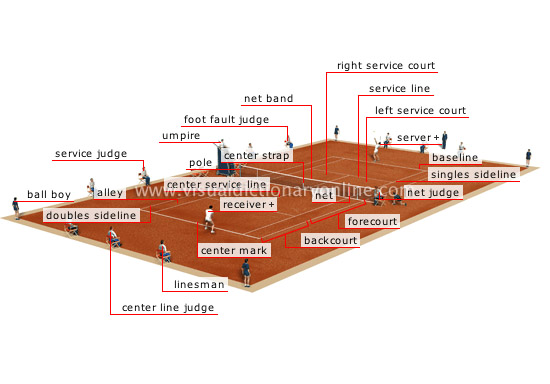court
Rectangular surface (78 ft x 27 ft for singles, 78 ft x 36 ft for doubles) designed for playing tennis; it is divided in half by a net.
center line judge 
Official who signals center line service faults and informs the umpire when the server commits a fault.
pole 
Vertical pole that stretches the net by means of a net band, keeping it 3.5 ft above the court.
doubles sideline 
Line that marks the sides of the playing area for doubles matches (two teams of two players).
service judge 
Official who signals service line faults and informs the umpire when the server commits a fault.
center mark 
Broken line marking the middle of the baseline; players use the center mark to take position for serving or receiving.
ball boy 
Person who retrieves balls from the court after each rally in a tournament.
alley 
Band that is 4.5 ft wide on the sides of the court; the alley is used only for doubles matches.
umpire 
Official responsible for applying the rules; the umpire ensures that the match runs smoothly and rules on contentious points.
receiver 
Player who returns the ball put into play by the server.
linesman 
One of the officials who ensure that the ball remains inside the lines of play and inform the umpire when a player commits a fault.
net judge 
Official responsible for calling net serves; the net judge also regulates net height before and during a match.
center strap 
Strip of fabric connected to the ground in the center of the net; it keeps the net at regulation height (3 ft).
net band 
Strip of fabric with a cable passing through it; it is attached to poles to suspend the net.
right service court 
Zone in which the serve must bounce; it is diagonally opposite the server.
net 
Loosely stitched divider stretched across the middle of the court; players must hit the ball over it.
singles sideline 
Line that marks the side of the playing area for singles matches (two players).
service line 
Line on each side of the net and parallel to it at a distance of 21 ft; it marks the back boundary of the service courts.
baseline 
Line marking the end of the court; the server stands behind the baseline.
server 
Player who puts the ball into play; the server and receiver must stand in diagonally opposite zones.
left service court 
Zone in which the serve must bounce; it is diagonally opposite the server.
backcourt 
Zone between the service line and the baseline.
forecourt 
Zone between the net and the service line.
center service line 
Line dividing each forecourt in half.


















